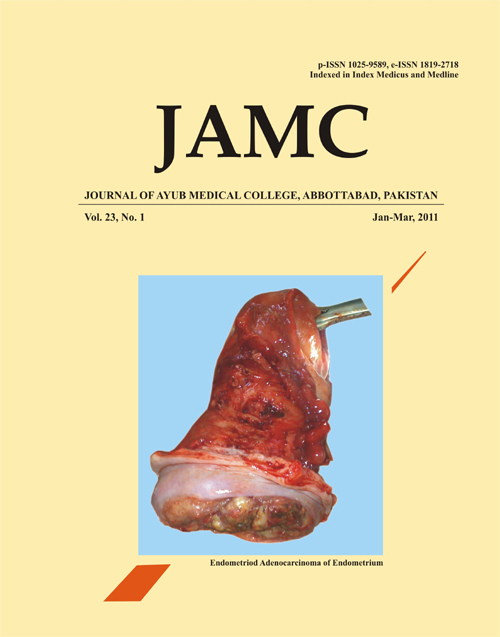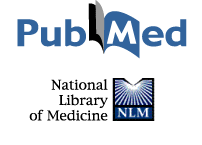INCIDENCE OF METHICILLIN RESISTANT STAPHYLOCOCCUS AUREUS IN PESHAWAR
Abstract
Background: There is considerable variation in the percentage of isolates of methicillin resistantStaphylococcus aureus (MRSA). There are several mechanisms for methicillin resistance. The mostimportant is low affinity of penicillin binding proteins for β-lactam antibiotics. The objectives of thisstudy were to establish the pattern of MRSA incidence in Peshawar in recent years, and to identify highrisk groups for acquiring infection amongst the city population. Method: All positive MRSA casesreported at city laboratory were employed in the study. These were recorded over the time periodelapsing from 2009 to 2011. For each patient, records were looked at for age, sex, specimen testedpositive, hospital/community acquired and if hospital acquired then which particular hospital within thecity was infection contracted at. Also patient records were addressed for any immune systemabnormalities, any operation conducted, presence or absence of diabetes and any history of intravenousdrug use. Results: There were a total of 929 MRSA cases in our study, of which 538 were males and391 were females. MRSA frequency for the year 2009 was 207, for 2010 it was 284 and for 2011 it was438. The frequency of MRSA increased by 54% from the year 2009 to 2011. Conclusion: Apotentially alarming increase in MRSA incidence within the city has been observed in recent yearsthreatening to rise further judging the current trend. Those at a high risk of contracting infection includemales aged between 20–29 years, hospitalised, diabetics, immune system compromised, andindividuals with a history of IV drug use.Keywords: MRSA, Incidence, PreventionReferences
Aasma N. Ajmal, Farzana Mir, Maleeha Aslam, Rubeena
Hafeez, Rubina Attique. Nosocomial methacillin-resistant
staphylococcus aureus frequency in a tertiary care hospital,
Lahore, Pakistan, Biomedica 2009; 25:97–100.
Fitzroy A Orrett, Michael Land. methicillin resistant
Staphylococcus aureus prevalence: current susceptibility patterns
in Trinidad. BMC Infectious Diseases 2006;6:83. Doi:
1186/1471-2334-6-83. URL: www.biomedcentral.com/1471-
/6/83.
Crawford SE, David MZ, Glikman D, King KJ, Boyle-Vavra
S, Daum RS. Clinical importance of purulence in methicillinresistant Staphylococcus aureus skin and soft tissue infections. J
Am Board Fam Med 2009;22(6):647–54.
Fankhauser CM, Schrenzel J, Pittet D, Harbarth S. Epidemiology
of MRSA at the University of Geneva Hospitals. BMC
Proceedings 2011;5(Suppl 6):5.
Statistical bulletin, deaths involving MRSA 2009. Office for
National Statistics UK. URL: www.ons.gov.uk
Laxminarayan Ramanan, Malani Anup. Resources for the Future,
Extending the Cure: Policy Responses to the Growing Threat of
Antibiotic Resistance March 22, 2007. Available at:
www.extendingthecure.org.
Ekrami A, Samarbafzadeh AR, Alavi M, Kalantar E, Hamzeloi
F. Prevalence of methicillin resistant Staphylococcus species
isolated from burn patients in a burn center, Ahvaz, Iran.
Jundishapur J Microbiology 2010;3(2):84–91.
Crowcroft NS. Mortality from methicillin resistant
Staphylococcus aureus in England and Wales: analysis of death
certificates. BMJ 2002;325:1390.
Published
Issue
Section
License
Journal of Ayub Medical College, Abbottabad is an OPEN ACCESS JOURNAL which means that all content is FREELY available without charge to all users whether registered with the journal or not. The work published by J Ayub Med Coll Abbottabad is licensed and distributed under the creative commons License CC BY ND Attribution-NoDerivs. Material printed in this journal is OPEN to access, and are FREE for use in academic and research work with proper citation. J Ayub Med Coll Abbottabad accepts only original material for publication with the understanding that except for abstracts, no part of the data has been published or will be submitted for publication elsewhere before appearing in J Ayub Med Coll Abbottabad. The Editorial Board of J Ayub Med Coll Abbottabad makes every effort to ensure the accuracy and authenticity of material printed in J Ayub Med Coll Abbottabad. However, conclusions and statements expressed are views of the authors and do not reflect the opinion/policy of J Ayub Med Coll Abbottabad or the Editorial Board.
USERS are allowed to read, download, copy, distribute, print, search, or link to the full texts of the articles, or use them for any other lawful purpose, without asking prior permission from the publisher or the author. This is in accordance with the BOAI definition of open access.
AUTHORS retain the rights of free downloading/unlimited e-print of full text and sharing/disseminating the article without any restriction, by any means including twitter, scholarly collaboration networks such as ResearchGate, Academia.eu, and social media sites such as Twitter, LinkedIn, Google Scholar and any other professional or academic networking site.









